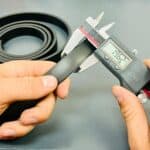When a car’s check engine light turns on, it could be due to a problem called engine code P0300. This code indicates that the car’s engine is experiencing a misfire, which means that one or more cylinders are not burning fuel correctly. The cylinders in the engine must fire correctly to keep the car running smoothly. Code P0300 occurs when these cylinders are not working correctly. This can cause the car to shake, and it may not have as much power as it should. It is essential to address this issue to ensure that the car runs properly.
Troubleshooting Engine Code P0300: Understanding Random Misfires
The P0300 engine code indicates one or more cylinders are misfiring on your car’s engine. This issue can lead to several performance problems and even cause damage if not addressed.
What Does P0300 Mean?
“P0300” is a generic OBD-II code (On-Board Diagnostics), meaning it applies to most vehicles manufactured after 1996. Here’s what it signifies:
- P: Powertrain (the engine, transmission, and related components)
- 0: Generic code
- 3: Ignition system or misfire detected
- 00: Random/multiple cylinder misfire
Symptoms of a P0300 Code
- Check Engine Light: The most obvious sign will be an illuminated check engine light on your dashboard.
- Rough Idling: The engine might feel shaky or vibrate while idling or when you come to a stop.
- Reduced Power: Your car might feel sluggish or have trouble accelerating.
- Poor Fuel Economy: Misfires lead to inefficient fuel burning, decreasing gas mileage.
- Engine Stalling: In severe cases, the engine may stall unexpectedly.
Common Causes of the P0300 Code
Here’s a breakdown of frequent problems that can trigger the P0300 code:
| Problem | Description |
|---|---|
| Faulty Spark Plugs | Worn or damaged spark plugs won’t ignite the fuel-air mixture properly. |
| Ignition System Issues | This includes problems with spark plug wires, coils, distributor cap (older vehicles), or ignition coil packs. |
| Fuel Delivery Problems | Clogged fuel injectors, a faulty fuel pump, or a bad fuel pressure regulator can disrupt fuel supply, causing misfires. |
| Vacuum Leaks | Leaks in the engine vacuum system allow unmetered air in, upsetting the necessary air-fuel ratio. |
| Low Compression | Problems like worn piston rings, leaking head gaskets, or burnt valves can result in low compression within cylinders. |
| Mechanical Issues | Severe engine wear, jumped timing chains/belts, or internal engine damage can also lead to misfires. |
Troubleshooting the P0300 Code
- Read the Code: Use an OBD-II scanner to read the specific codes. If there are codes P0301 to P0308, they indicate misfires on specific cylinders.
- Check the Basics: Inspect the spark plugs, wires, coil packs, and distributor cap (if applicable) for signs of wear or damage.
- Inspect for Vacuum Leaks: Carefully listen for hissing sounds and inspect vacuum lines for cracks or disconnections.
- Further Diagnostics: If the issue persists, advanced diagnostics may be involving testing the fuel system, checking engine compression, or investigating potential timing issues.
Important: Ignoring a P0300 code can lead to decreased performance, increased emissions, and potentially cause costly damage to your engine or catalytic converter. Seek professional assistance if needed.
Understanding P0300 Code and Misfires
When the engine in a car is not running smoothly, it might show an error code called P0300. This code means the engine has misfires that are not set to one cylinder.
Causes of P0300 Code
Misfires happen for various reasons. They can be due to problems with:
- Ignition system: This includes spark plugs, ignition coils, and wires.
- Fuel system: Issues might be with the fuel injectors or fuel pressure.
- Air flow: A vacuum leak can cause trouble with air entering the engine.
- Engine timing: If the camshaft or crankshaft are not timed well, misfires can occur.
- Sensor failures: Faulty oxygen sensors or issues with the PCM can report or cause misfires.
Symptoms of Engine Misfire
The signs of an engine misfire might include:
- The engine is hard to start.
- It runs rough or stutters.
- There’s a lack of power during acceleration.
- Fuel economy drops.
- The check engine light turns on.
Diagnosis and Tools
To figure out why P0300 shows up, people use tools like:
- OBD-II scanner: This reads the car’s error codes.
- Multimeter: It tests electrical parts like sensors and coils.
- Compression test: This checks if the engine’s cylinders are healthy.
- Smoke machine: It finds leaks that air or fluids might escape from.
The first step in diagnosing is to get the error codes with the OBD-II scanner. Next, a mechanic will check the ignition and fuel system. They’ll look for trouble with spark plugs or fuel injectors. Lastly, they might check the engine’s timing and sensors. It’s like being a detective to find out what is wrong with the engine.
Repairing Misfires and Preventive Maintenance
The correct fix for a misfire can prevent more damage. Regular maintenance stops misfires from happening.
Fixing Common Misfires
When a car’s engine misfires, one or more cylinders don’t fire right, disrupting the engine’s power and function. A misfire can be due to many issues. You can start with simple repairs before moving on to more complex ones. Begin with a visual check of the following components:
- Spark Plugs and Wires: Look for wear or damage. Replace them if needed.
- Ignition Coils: These provide the spark for the plugs. Test and replace if they fail to work.
- Fuel System: The fuel pump, filter, and injectors must deliver the right amount of gas. Clean or replace any parts that look dirty or worn.
- Air System: An engine needs air just like it needs fuel. Make sure the air filter is clean and the air intake system is free of blockages.
- Wiring and Sensors: Check the wiring and O2 sensors. Damaged wiring or faulty sensors need replacements.
- Head Gasket: If damaged, it may let coolant into the cylinders, causing misfires.
Reset the engine control unit (ECU) after repairs. This clears old errors and lets the ECU relearn with the fixes.
Ongoing Engine Maintenance
Keep your car running smoothly with regular maintenance. This helps prevent serious problems in the engine. Use the maintenance guide below:
- Fuel System: Replace the fuel filter as suggested by your car’s maker. Check the fuel pressure regularly.
- Ignition System: Change spark plugs and inspect ignition coils in intervals stated by your vehicle.
- Air System: Swap out air filters and inspect the throttle position sensor as needed.
- Battery: Ensure it’s charged and connections are clean. A weak battery can lead to engine problems.
- Regular Check-ups: Scan the ECU for error codes often. Early detection of errors can save you from big repairs.
Follow the vehicle’s manual for the best timing on maintenance. Remember, keeping up with these tasks is the key to a healthy engine.
Frequently Asked Questions
This section provides clear answers to common questions about the P0300 engine code.
What steps should be taken to resolve a P0300 engine code?
To fix a P0300 code, first, check the spark plugs and ignition coils. If they are old or worn, replace them. Also, inspect the fuel system and air intake for problems. A mechanic can help with these tasks.
Can driving with a P0300 code result in further vehicle damage?
Yes, driving with a P0300 code can harm the vehicle if not fixed soon. The code means the engine is misfiring. This can hurt the engine over time.
What is the most likely reason for a vehicle to show a P0300 code?
The most common cause of a P0300 code is a misfire in several engine cylinders. It can happen due to faulty spark plugs, ignition system issues, or fuel delivery problems.
Could replacing spark plugs lead to a P0300 code appearing?
No, replacing spark plugs should not cause a P0300 code. If the code appears after replacement, the new spark plugs may be faulty, or they were installed incorrectly.
What sensors are potentially linked to triggering a P0300 code?
Sensors related to a P0300 code include the oxygen sensor, mass airflow sensor, and crankshaft position sensor. These monitor engine functions.
After diagnosing a P0300 code, is it safe to continue driving the vehicle?
It is not safe to keep driving if a P0300 code shows up. The engine misfire can get worse. This can cause damage or a breakdown. Have the vehicle checked by a professional mechanic promptly.







